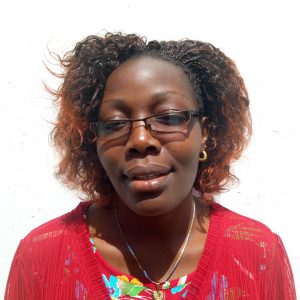Ematetie village is covered with green vegetation both naturally occurring and planted. The fertile land supports community members' farming, which most people do on a small scale. The area is flat though somewhat sloping, and houses are closely concentrated. Although most families have many children in this community, a unique superstition says that if a parent mentions the specific number of children they have may, it may lead to a child's death.
500 people in Ematetie depend on Amasetse Spring as their year-round water source. The community members waste time fetching water using a jug to scoop water from the open water source into their larger jerrycans, which are too large to submerge in the puddled water. At times, the spring water is so dirty that people are forced to wait until it settles to begin fetching, which can waste several more hours. Some people come with sieves so that they sieve the spring water as they pour it into their containers in an effort to remove the largest pebbles, dirt, and bugs.
Women and cihldren waste a lot of time accessing the spring water which affects the entire schedule of their day. This is because only one person at a time can fetch water slowly using a jug to avoid dirtying it further. The long waits have sometimes been hard, causing quarrels and even fights among frustrated community members.
"Fetching water from this water point has really affected my daily activities. I always wish to fetch water before I go to the shamba (farm), but when I come for water, I always find people already full at the water point which discourages me. The water is also open to contamination and this makes me worried of anything going wrong, either diseases or the water being poisoned," explained Martha Makhoya.
"After a few people have fetched water, it gets dirty and the rest are forced to wait until the dirt settles down. This really wastes time and inconveniences people. We also suffer from waterborne diseases because of the dirty water," said young teenager Paul.
Community members say they most commonly contract typhoid and dysentery as a result of drinking the contaminated spring water. These diseases are expensive to treat, draining families of their financial resources, energy, and time. When sick, kids have to stay home from school, and adults miss out on key productive time at work, at home, and on the farm.
What We Can Do:
Spring Protection
Protecting the spring will help provide access to cleaner and safer water and reduce the time people have to spend to fetch it. Construction will keep surface runoff and other contaminants out of the water. With the community’s high involvement in the process, there should be a good sense of responsibility and ownership for the new clean water source.
Fetching water is a task predominantly carried out by women and young girls. Protecting the spring and offering training and support will, therefore, help empower the female members of the community by freeing up more of their time and energy to engage and invest in income-generating activities and their education.
Training on Health, Hygiene, COVID-19, and More
To hold trainings during the pandemic, we work closely with both community leaders and the local government to approve small groups to attend training. We ask community leaders to invite a select yet representative group of people to attend training who will then act as ambassadors to the rest of the community to share what they learn. We also communicate our expectations of physical distancing and wearing masks for all who choose to attend.
The training will focus on improved hygiene, health, and sanitation habits in this community. We will also have a dedicated session on COVID-19 symptoms, transmission routes, and prevention best practices.
With the community’s input, we will identify key leverage points where they can alter their practices at the personal, household, and community levels to affect change. This training will help to ensure participants have the knowledge they need about healthy practices and their importance to make the most of their water point as soon as water is flowing.
Our team of facilitators will use a variety of methods to train community members. Some of these methods include participatory hygiene and sanitation transformation, asset-based community development, group discussions, handouts, and demonstrations at the spring.
One of the most important issues we plan to cover is the handling, storage, and treatment of water. Having a clean water source will be extremely helpful, but it is useless if water gets contaminated by the time it is consumed. We and the community strongly believe that all of these components will work together to improve living standards here, which will help to unlock the potential for these community members to live better, healthier lives.
We will then conduct a small series of follow-up trainings before transitioning to our regularly scheduled support visits throughout the year.
Training will result in the formation of a water user committee, elected by their peers, that will oversee the operations and maintenance of the spring. The committee will enforce proper behavior around the spring and delegate tasks that will help preserve the site, such as building a fence and digging proper drainage channels. The fence will keep out destructive animals and unwanted waste, and the drainage will keep the area’s mosquito population at a minimum.

 Protected Spring
Protected Spring
 Rehabilitation Project
Rehabilitation Project










































